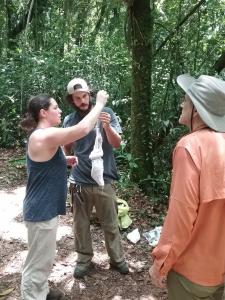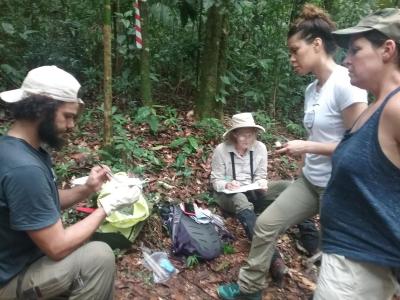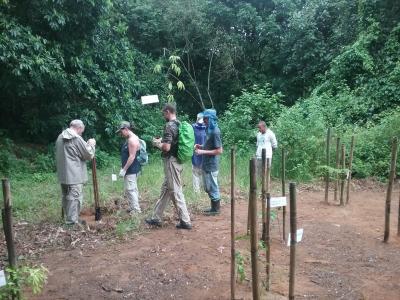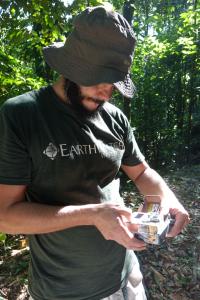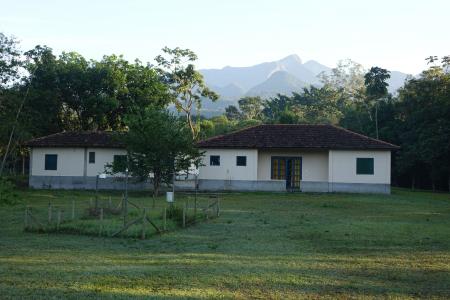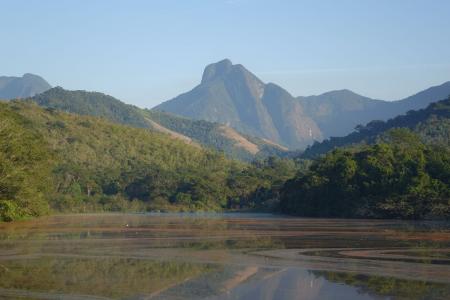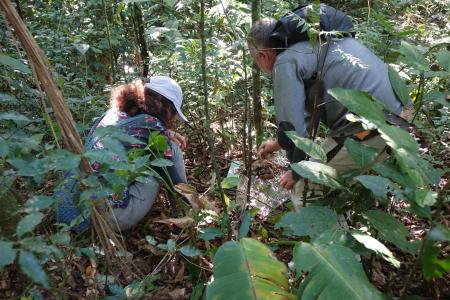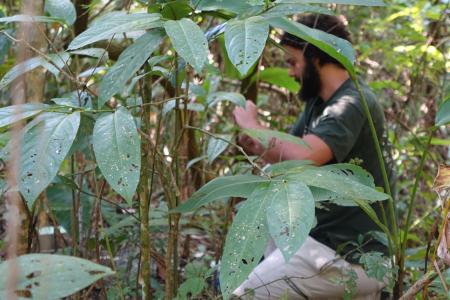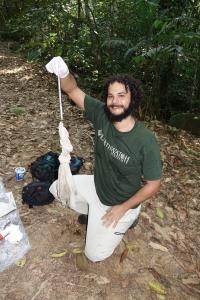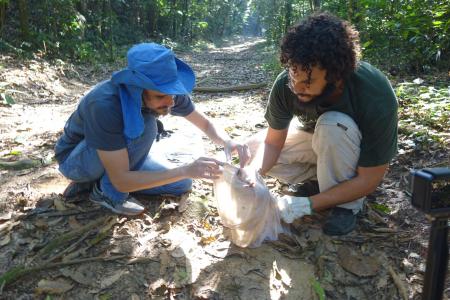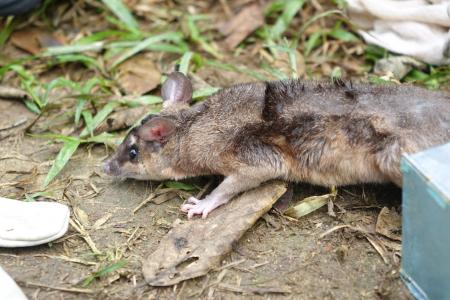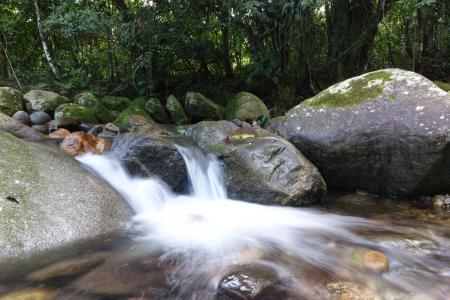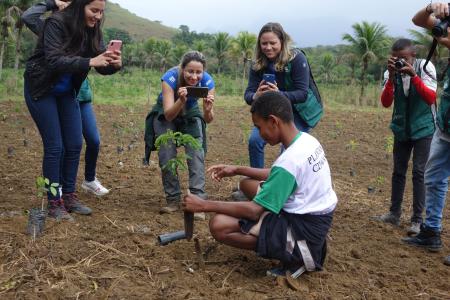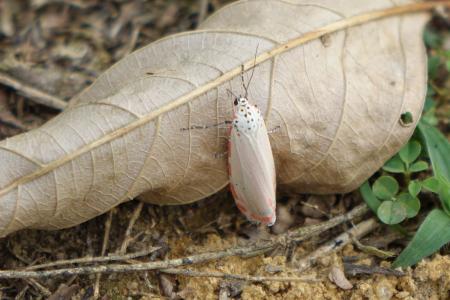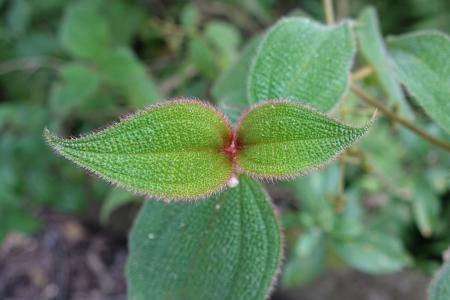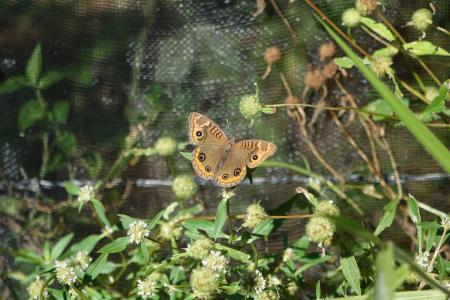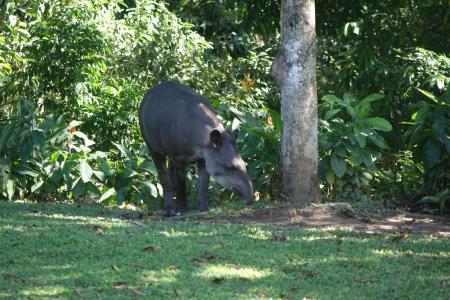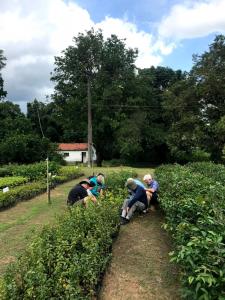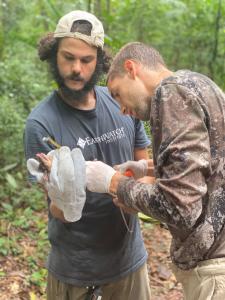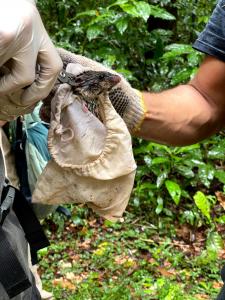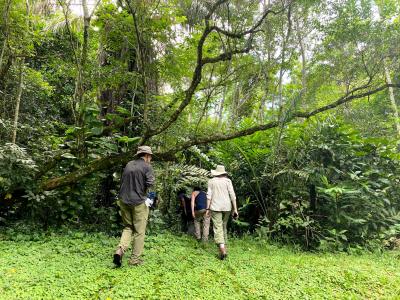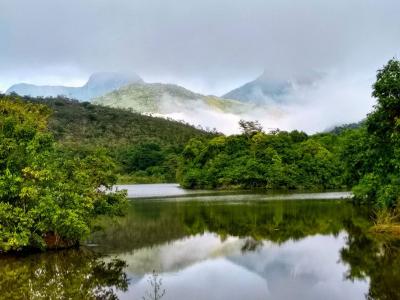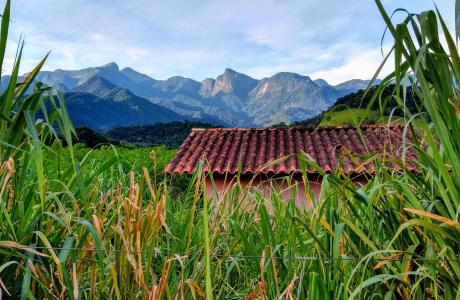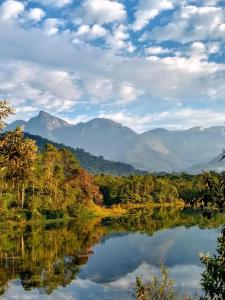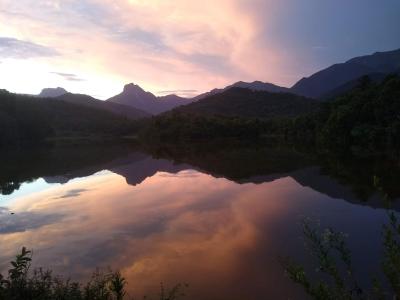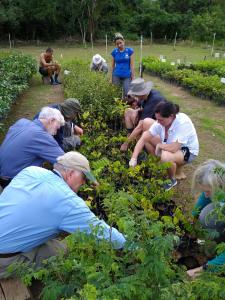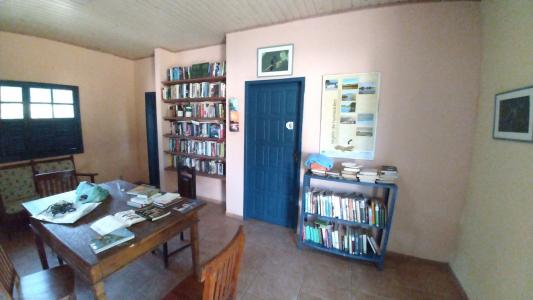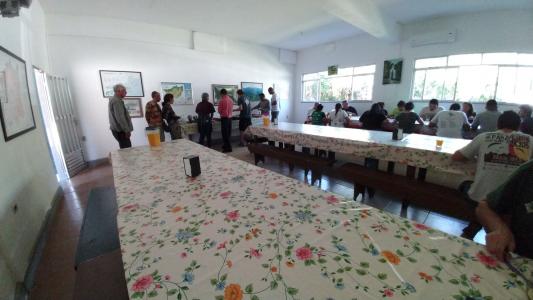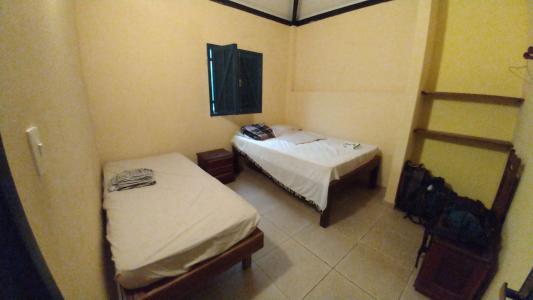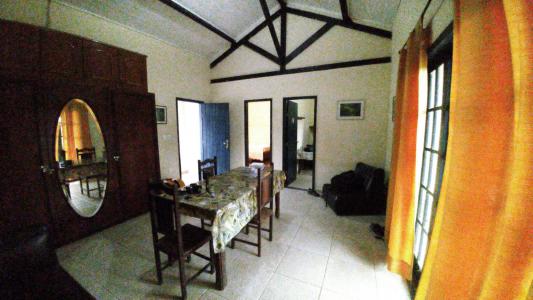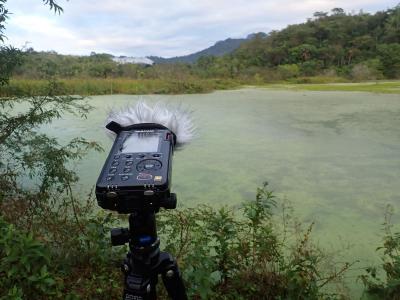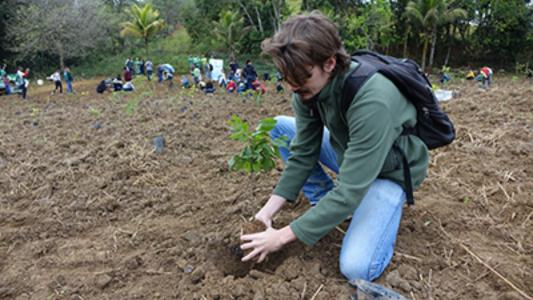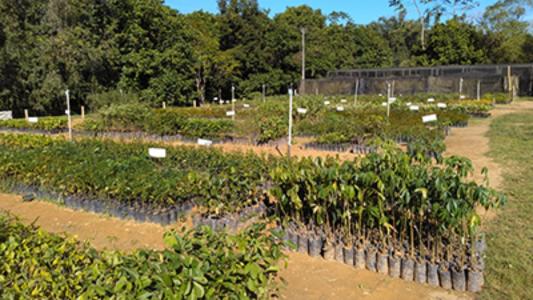Please read the following information carefully before leaving for your expedition.
Wildlife and Reforestation in Brazil
Expedition Briefing
Quick Navigation: COVID-19 Safety | The Research | Research Aims | How You Will Help | Life in the Field | Accommodations and Food | Project Conditions | Essential Eligibility Requirements | Health and Safety | Project Risks and Precautions | Travel Planning | Additional Resources
Click on the images to view full size!
COVID-19 Safety
You are strongly encouraged to test for COVID-19 before traveling to your expedition, particularly if you are experiencing symptoms. Do not travel if you have tested positive, and call Earthwatch right away for the next steps. Please see earthwatch.org/covid-19 for more information.
The Research
The Atlantic Forest extends along the coast of Brazil, stretching over the rolling mountains of the Serra dos Órgãos mountain range to the mangrove forests on the coast. The forest is thought to have originally covered 390,000–580,000 square miles, but it has shriveled to a small fraction of its original span. Only 11.6% of the natural vegetation cover remains, and the forested areas still standing are extremely disconnected from one another.
This forest plays a significant role in the global carbon budget, contains an important share of all plant and animal species in the region, and is economically critical for national and international markets. Preserving these ecosystem functions is crucial to Brazil and the world, as Latin American forests comprise about 27% of global forest cover. However, preserving this landscape is becoming more difficult than ever before as climate change further degrades the forests. According to the United Nations, tropical South America may be one of the regions most affected by global climate change.
The deforestation of the Atlantic Forest and its susceptibility to climate change exacerbate each other. Forest fragmentation has profound impacts on the surrounding landscapes, as native vegetation plays an important role in mitigating erosion. As the forest shrinks, it can no longer effectively regulate local rainfall and temperature or store carbon. In turn, this makes the area more susceptible to the harmful effects of climate change.
Recognizing the dire need to preserve the Atlantic Forest and restore it, Brazil’s government, conservation organizations, and NGOs have invested in large-scale reforestation efforts. For these projects to be successful, they need to restore the trees and the ecosystem functions of the original forest. Currently, there is little research on how much and in what ways reforestation restores an ecosystem. While reforestation is urgently needed, strong scientific data is essential to making sound and sustainable decisions.
Mammals act as an essential part of ecosystems, regulating various interactions between animals at every food chain level (Estes et al., 2011). Small terrestrial mammals, like rodents, comprise the largest and most diverse mammals in many ecosystems. This group is usually the main prey for many other species and directly affects the composition of the plant community by eating and dispersing seeds. Therefore, the number and types of mammals in an area is a valuable indicator of how well the ecosystem functions.
This project will investigate populations of small, medium, and large mammals, from the small southeastern four-eyed opossums (Philander frenatus) to the large puma (Puma concolor), to address the effectiveness of reforestation in the conservation of mammal populations in the Atlantic Forest. Rigorous, long-term monitoring of mammal populations is uncommon in such ecosystems, and this is the first systematic study to monitor the fauna of Atlantic Forest restoration efforts. The project will give stakeholders significant insight into managing forests best and reforestation efforts to maximize mammalian conservation and recolonization of reforested areas.
Wildlife and Reforestation in Brazil
Research Aims
The main goal of this study is to establish and implement a long-term monitoring program for mammal populations in reforested and control areas before, during, and after reforestation actions in the Atlantic Forest. To achieve this, we will use a robust field protocol (Before-After-Control-Impact or BACI) to assess the success of reforestation efforts and how those efforts impact mammal populations. This study focuses on collecting population dynamics information about mammals in different habitat types: reforested stands, sites with pastures and small forest remnants, and sites of continuous mature forests as control sites.
Volunteers will assist in setting live traps and camera traps. The small and medium mammals collected in the live traps will be weighed, measured, sexed, marked with ear tags, and released. The camera traps will collect images of the larger mammals moving throughout the reserve, providing information about animals that are more difficult to capture and handle. The data collected from the reforested areas will be compared to the data from the two areas that have not been reforested to determine how mammal populations are responding to this new habitat.
Some teams will also help monitor the success of the reforestation effort. Volunteers will measure the growth of planted species and changes in vegetation structure, including measuring the diameter of the trees (to assess growth) and the amount of canopy coverage. Volunteers will also work directly on reforestation by processing seeds, weeding, organizing the nursery, or sorting seeds by species. Depending on the season, some groups can plant the seedlings in degraded areas (primarily during the rainy season from December to March).
The project aims to answer the following questions:
- Is the reforestation being followed by the re-establishment of mammal populations?
- Which mammal species occupy reforested areas? Which do not?
- Are ecosystem processes being lost by the absence of specialized mammal species?
- Is there a succession of mammal species in the reforestation process? Does it follow a pattern?
This project aims to combine ecological global thinking and local action to mitigate ongoing global changes. The volunteers on this project will participate in the first ecological research on reforestation involving mammals in the Atlantic Forest.
Wildlife and Reforestation in Brazil
How You Will Help
REGUA consists of 6,700 hectares of farmland, fragmented forest, and reforested stands and is home to 480 bird species, 73 amphibian species, and 61 species of mammals, including the endangered southern wooly spider monkey or muriqui (Brachyteles arachnoides) and the elusive puma. Volunteers will spend most of their time in the field, experiencing this rich biodiversity. You will help collect information on the activities of mammals inside the reserve, measure the success of reforestation, and help with reforestation efforts. In addition, you will help catalog the data you collect.
As part of this team, you will:
- Conduct mammal surveys: You will spend much of your time collecting data on mammal activity in different types of forests. You will be trained to install camera traps and live traps on the ground and in the canopy. Throughout your stay, you’ll collect the recordings from the camera traps and handle and process the small mammals, such as southeastern four-eyed opossums, caught in the live traps (not obligatory). You will spend some time helping to enter data recorded in the field into the project’s database.
- Measure the success of reforestation: While in the field, you will also help to measure the growth and health of reforested areas. You will mark and measure tree diameter, the proximity of other trees (density), tree condition, the canopy coverage of the area, and other vegetation structural variables in a defined plot set in most restored areas. Those metrics allow the scientists to estimate carbon sequestration rates relative to weather patterns and based on species-specific allometric curves of tree growth. This research component is a truly important activity for the restoration of the Atlantic Forest because that data is directly connected to climate change and its mitigation.
- Help with reforestation activities: An important part of this project is the effort to reforest the Atlantic Forest region. You will have the opportunity to aid in this effort by harvesting seeds from the forest, processing the seeds, organizing the seeds by species, or organizing and weeding the nursery. Depending on the season, teams will also have the opportunity to plant seedlings in areas targeted for reforestation, giving them a protected home for decades.
Wildlife and Reforestation in Brazil
Life in the Field
During the first two days, you will go on an orientation hike with the Earthwatch scientist or a staff member and spend time learning the techniques in the laboratory/classroom. You will then practice the various jobs under staff supervision. You will also be given lectures on topics such as an introduction to mammals, the theory behind the project, the methods to be used, and the plan of action. We will also hear from Nicholas Locke, president of REGUA research station where teams will stay, on the local area and his team’s vision for restoring the Atlantic Forest ecosystem there,
DAILY ACTIVITIES
Weather and research needs can lead to changes in the daily schedule. We appreciate your cooperation and understanding. During strong storms, trees and branches can fall and block the road. The REGUA team is prepared with the tools necessary to reopen the path, but this work can take some time and may impact the daily schedule.
The team will be divided into groups, with the composition changing frequently to allow everyone to get to know each other. The tasks are varied enough that each volunteer will usually find a niche and feel satisfied with their contribution to the team effort.
When the team is not working, many activities contribute to team development. Each evening, there will be time for discussions about the research progress and the volunteers' feedback.
In the exciting world of ecological field research, there is often a blurry line between work and play. Many volunteers find the “work” enjoyable, and some have even seen it as a life-changing experience. You will most likely experience a steep learning curve over the first few days of the project and will be pleasantly surprised at how much you have learned and accomplished by the end of the project.
On some days, monitoring small mammals in the morning can finish early so the team can cool off in the nearby river. Swimming is only permitted for participants 18 years of age and older and at one's own risk as there is no lifeguard on duty.
ITINERARY
- Day 1: Arrive at the field station, introductions, and dinner.
- Day 2: Travel to the field site, orientation walk, and training on research tasks.
- Days 3–4: Fieldwork
- 7:00 a.m.: Breakfast
- 8:00 a.m.: Fieldwork
- Noon: Lunch
- 1:00 p.m.: Fieldwork
- 2:30 p.m.: Fieldwork/ Nursery work
- 6:00 p.m.: Dinner
- 7:30 p.m.: Discussion and planning time
- 8:30 p.m.: Recreational time (good time for night walks, talking to other biologists or visitors, and catching up on emails)
- Day 5: One recreational day (this day is not fixed and may occur earlier depending on the team’s energy). During the recreational day, volunteers can bird watch and/or hike in the Atlantic Forest along set hiking trails.
- Day 6: Fieldwork
- 7:00 a.m.: Breakfast
- 8:00 a.m.: Fieldwork
- Noon: Lunch
- 2:30 p.m.: Fieldwork/Nursery work
- 6:00 p.m.: Dinner
- 7:30 p.m.: Finish all projects and data entry; 1-week team members will pack for their departure on Day 7.
- Day 7: Depart for the airport at 8:30 a.m.
RECREATIONAL TIME
- Bird watching: There are now over 470 species of birds that have been confirmed at REGUA in a bird list with English and scientific names.
- Hiking: REGUA has an extensive trail network that takes you deep into the lowland Atlantic Forest through restored lowland wetlands and past unspoiled rivers and waterfalls. The most regularly used tourist trails are clearly marked with colored posts every 50 meters and regularly cleared and maintained.
- Photography: There will be plenty of opportunities for photos, especially in the nearby wetlands, which have shelter/hides and an observation tower where tapirs, capybaras, herons, and many other animals can be observed in their natural environment.
Wildlife and Reforestation in Brazil
Accommodations and Food
* Please note that not every expedition has couples’ or singles' accommodations available. Please call or email Earthwatch to check availability before reserving your space(s) on the team.
SLEEPING
The Reserva Ecológica de Guapiaçu (REGUA) Conservation Centre has six small cottages, each with 2–12 beds. The cottages each have their own toilet and shower with hot water and 110V electricity. The houses are also equipped with basic furniture. REGUA Staff can provide laundry service at $3.00 per piece.
The houses are adjacent to the project’s restored wetlands with marked trails that provide stunning views of the forest and Serra dos Órgãos mountains.
Single and couples’ rooms are available but will depend upon the overall size and gender breakdown of the team. Sheets, pillowcases, and towels are provided.
* Earthwatch will honor each person’s assertion of gender identity respectfully and without judgment. For both teen and adult teams, where logistics dictate single-sex accommodations or other facilities, participant placements will be made in accordance with the gender identity the participant specified on their Earthwatch Participant form and/or preferences indicated in discussions with Earthwatch.
BATHROOMS
Bathrooms are unisex and shared. They have flush toilets and private shower stalls. Showers have hot water.
ELECTRICITY
All rooms have electricity. Electric sockets are 110 volts (type C and N).
PERSONAL COMMUNICATIONS
Open-access Wi-Fi is available at the main station. The study areas usually have some cell coverage with an international plan in place (TIM is the only mobile operator that works in the region. A prepaid card can be purchased at stores in Rio de Janeiro or the airport).
Please note: Earthwatch encourages volunteers to minimize outgoing calls and immerse themselves in the experience; likewise, family and friends should restrict calls to urgent messages only. Emergency communications will be prioritized.
DISTANCE TO THE FIELD SITE
The field sites are approximately 20 minutes from the field station. Volunteers will ride on wooden benches in the back of a truck to reach the field sites. In the rare event that fallen trees block parts of the road, the team may need to walk the remaining distance to the field site, likely at most 4 km (2.5 miles) on generally flat terrain.
SERVICES AND RESTAURANTS IN WALKING DISTANCE
The accommodations are within walking distance of two small villages, about 1 hour or less walking. There is a small shop that sells groceries and personal care products and a few small bars where you can purchase cold drinks and other incidentals, but we encourage everyone to stay within REGUA during their team.
FOOD
The accommodations have a dedicated cook staff to prepare local Brazilian dishes for breakfast, lunch, and dinner.
TYPICAL MEALS
The following are examples of foods you may find in the field. Variety depends on availability. We appreciate your flexibility.
- Breakfast: May include bread, cold cuts, eggs, fruit, cereal, honey, and coffee.
- Lunch and Dinner: Beans, rice, soup, fried or cooked potatoes, salad, meat (beef, chicken, or pork and substitute for vegetarians), vegetables, fruit, pasta, salad with tomatoes and cucumbers, grated beets, and carrots.
- Snacks: Chocolate cake, paçoca (peanut candy)
- Beverages: Water, fruit juices. Please bring a reusable personal bottle for carrying drinking water to field sites. There is a filter that provides cold-filtered, potable water. Drinking tap water is not recommended.
SPECIAL DIETARY REQUIREMENTS
Please alert Earthwatch to any special dietary requirements (e.g., diabetes, lactose intolerance, nut or other food allergies, vegetarian or vegan diets) as soon as possible and note them in the space on your volunteer forms.
This project can cater to vegetarian, vegan, dairy-free, and gluten-free diets.
Wildlife and Reforestation in Brazil
Project Conditions
GENERAL CONDITIONS
Please visit Wunderground.com and search for your project location for weather and region-specific information.
Wildlife and Reforestation in Brazil
Essential Eligibility Requirements
All participants must be able to:
- Walk over uneven, forested, mountainous terrain for two to four hours for one to three miles (1.6 to 4.8 kilometers) daily, often in high temperatures and high humidity.
- Spend much of the day bent at the waist and ride on a wooden bench over bumpy dirt roads. People with back and hip issues may find these tasks difficult.
- Enjoy being outdoors all day in all types of weather, including high temperatures and high humidity. Temperature range during the day:
- January teams: 30-40 °C (86-104 °F)
- March teams: 30-35 °C (86-95 °F)
- July teams: 25-30 °C (77-86 °F)
- November teams: 28-35 °C (82-95 °F)
- Enjoy working outdoors in both sun and rain. January and March teams run during the wet season when there is a higher chance of rain.
- Get low enough to access and collect samples on the ground and in the brush for at least one hour daily.
- Do without C-PAP machines for the length of the project, as the electricity is mostly reliable, but there are sometimes outages.
- Carry personal daily supplies, such as lunch, water, and a camera.
- Help carry field equipment such as live traps and camera traps.
- Follow verbal and/or visual instructions independently or with the assistance of a companion.
- Take an active role in one’s safety by recognizing and avoiding hazards if and when they arise (including, but not limited to, those described in Earthwatch materials and safety briefings). Always comply with project staff instructions and recommended safety measures.
- Be able to effectively communicate to the staff if experiencing distress or need assistance.
- Be able to get along with a variety of people from different backgrounds, often in close proximity, for the duration of the team.
- Be comfortable being surrounded by a language and/or culture that is not your own.
- Enjoy teamwork and function cohesively within a group.
Wildlife and Reforestation in Brazil
Health and Safety
EMERGENCIES IN THE FIELD
At the field station, phone and email are available for emergency communications.
Earthwatch has a 24-hour, 7-day-a-week emergency hotline number. Someone is always on call to respond to messages that come into our live answering service.
IMMUNIZATIONS & TRAVEL VACCINATIONS
Please be sure your routine immunizations are up to date (for example, diphtheria, pertussis, tetanus, polio, measles, mumps, rubella, and varicella) and that you have the appropriate vaccinations for your travel destination. Medical decisions are the responsibility of each volunteer and their doctor. Visit the Center for Disease Control and Prevention or the World Health Organization for guidance on immunizations.
If traveling from countries or regions where yellow fever is endemic, you must have a certificate of vaccination.
It is strongly encouraged that you stay up to date with your COVID-19 vaccinations, including receiving booster doses, as applicable.
Wildlife and Reforestation in Brazil
Project Risks and Precautions
TRANSPORTATION
The land cruiser and van will occasionally transport volunteers over wet, winding, paved roads. Participants must wear seat belts whenever available and may not drive project vehicles.
TERRAIN
The terrain is very hilly, and some trails are quite steep. Some trails can get very slippery, and the mud trails are sometimes difficult to navigate due to water and deep mud. Walking slowly and carefully can prevent injury. Bring appropriate footwear, and remember that the hiking can be as strenuous or easy as appropriate. Please bring at least one to two liters (approx. 33 to 100 ounces) of drinking water on the transects. Walk slowly and rest frequently if overheated. You must always wear field boots and field clothes.
SWIMMING
There is a river near the research site. There will be opportunities to swim during downtime for participants 18 or older. Please note that no lifeguard is on duty, so volunteers swim at their own risk. Always notify a staff member when you will be swimming, and never swim alone, at night, or after consuming alcohol.
ANIMALS/PLANTS
There are venomous snakes, some irritating plants, and plenty of biting and stinging insects. Snakebites are uncommon, but using tall rubber boots (not required) in the field and flashlights at night are good precautions. Strong insect repellent can be used to ward off mosquitoes, chiggers, ticks, biting flies, and other insects, but please apply repellents in advance of research tasks and do not reapply when near mammal traps or when the scientists are handling an animal. Most plants are harmless to people, but some plants are poisonous and can cause rashes or have sharp spines or thorns. These will be pointed out to the volunteers.
INSECTS
Biting and/or stinging bees, wasps, bullet ants, scorpions, and spiders are all present in the research area. Team members will occasionally be bitten or stung, but these injuries are usually not severe. Anyone who develops an allergic reaction will be taken to the nearest clinic.
DISEASES
Diseases found in this region include hepatitis, typhoid, malaria, and rabies. You can decrease your risk of most diseases by avoiding mosquito bites, wearing protective clothing and shoes, practicing good hygiene, and drinking only bottled or filtered water when appropriate. Whether you have been vaccinated or not, it is always important to avoid stray dogs. The pre-exposure vaccination for rabies does not eliminate the need for post-exposure medical attention and treatment. Still, it does provide additional protection against the disease in the event of a delay in treatment. In addition, bites or scratches should be immediately and thoroughly washed with soap and clean water. If you feel ill once you return from your trip, inform your doctor that you have recently returned from a tropical region.
Please see the US Centers for Disease Control and Prevention (cdc.gov) or the World Health Organization (who.int) websites for more information on these conditions and how to avoid them.
YELLOW FEVER
At the time this briefing was produced, The CDC recommended a Yellow Fever vaccination for this particular area of Brazil. The project site is northeast of Rio De Janeiro and is in an area where Yellow Fever is Endemic. Please refer to the CDC website for vaccination suggestions: https://wwwnc.cdc.gov/travel/destinations/traveler/none/brazil, and consult your physician for specific recommendations.
CLIMATE/WEATHER
It will be hot and humid. You will need to protect yourself from the sun with appropriate clothing and sunscreen (at least 30 to 60 SPF) and drink plenty of water throughout the day to avoid dehydration. It can rain at any time of the year, so please bring light rain gear suitable for tropical climates. Those using hearing aid devices may find they don’t work properly.
PERSONAL SECURITY
Always stay with a group when on the expedition. Please leave valuables at home or properly secured at the field station or research sites.
REGUA has lockers where you can store valuables, though you will need to bring a lock (with keys or a combination) to secure your items.
DISTANCE FROM MEDICAL CARE
This project site is 40 minutes away from the nearest fully equipped hospital. If you are pregnant or have other conditions that could require emergency medical care, you should discuss this with your physician before joining this project.
RISK OF COVID-19 OR OTHER RESPIRATORY ILLNESS
Earthwatch strongly encourages you to take precautions to help protect yourself and others from common viral respiratory illnesses, including COVID-19, flu, and RSV: stay up to date with your vaccinations; wash your hands frequently; take steps to improve air quality, for example, by increasing ventilation indoors or gathering outdoors; and use preventative measures to limit the spread if you are sick.
Persons with a higher risk of severe respiratory illness should consult their healthcare provider before participating.
Wildlife and Reforestation in Brazil
Travel Planning
RENDEZVOUS LOCATION
Rio de Janeiro—Antonio Carlos Jobim International Airport, Brazil
* Earthwatch will provide additional information to meet your team. Please only book travel arrangements such as flights once you have received further information from Earthwatch.
ABOUT YOUR DESTINATION
Earthwatch strongly recommends that travelers investigate their destination before departure. Familiarity with the destination’s entry/exit requirements, visas, local laws, and customs can go a long way to ensuring smooth travel. The U.S. Department of State's Traveler’s Checklist and Destination Guides are helpful resources. For LGBTI travelers, the U.S. Department of State's LGBTI Travelers page contains many helpful tips and links.
COUNTRY AND PROJECT ENTRY REQUIREMENTS
You are responsible for reviewing and abiding by your destination's entry/exit requirements.
Entry visa requirements differ by country of origin, layover, and destination and do change unexpectedly. For this reason, please confirm your visa requirements at the time of booking and again 90 days before travel. Please apply early for your visa (we recommend starting six months before the start of your expedition). Refunds will not be made for volunteers canceling due to not obtaining their visa in time to meet the team at the rendezvous. You can find up-to-date visa requirements at the following website: travisa.com.
If a visa is required, participants should apply for a TOURIST visa. Please note that obtaining a visa can take weeks or even months. We strongly recommend using a visa agency to expedite and simplify the process.
Wildlife and Reforestation in Brazil
Resources
BOOKS
- Eisenberg, J. F. and Redford, K.H. 2000. Mammals of the Neotropics: The Central Neotropics: Ecuador, Peru, Bolivia, Brazil: 3. University of Chicago Press.
- Emmons, L. H. 1997. Neotropical Rainforest Mammals: A Field Guide. University of Chicago Press.
- Kricher, J. 2017. The New Neotropical Companion. Princeton University Press.
- Hunter, L. 2011. Carnivores of the World. Princeton Field Guides
- Borges, P.A. , Tomás W.M.Guia de Rastros e outros vestígios de mamíferos do Pantanal. Embrapa.
- Dean W. 1998. A Ferro e Fogo—a História e a devastação da Mata Atlântica. Companhia das Letras.
- With Broadax and Firebrand, The Destruction of the Brazilian Atlantic Forest, (A Centennial Book) by Warren Dean (Author), Stuart B. Schwartz (Foreword)April 1997. First Edition
ARTICLES
- Crouzeilles, R., Ferreira, M. S., Chazdon, R. L., Lindenmayer, D. B., Sansevero, J. B. B., Monteiro, L., … Strassburg, B. B. N. (2017). Ecological restoration success is higher for natural regeneration than for active restoration in tropical forests. Science Advances, 3(11), 1–8. https://doi.org/10.1126/sciadv.1701345
- Ribeiro, M. C., Metzger, J. P., Martensen, A. C., Ponzoni, F. J., & Hirota, M. M. (2009). The Brazilian Atlantic Forest: How much is left, and how is the remaining forest distributed? Implications for conservation. Biological Conservation, 142(6), 1141–1153. https://doi.org/10.1016/j.biocon.2009.02.021
- Rodrigues, R. R., Lima, R. a. F., Gandolfi, S., & Nave, A. G. (2009). On the restoration of high diversity forests: 30 years of experience in the Brazilian Atlantic Forest. Biological Conservation, 142(6), 1242–1251. https://doi. org/10.1016/j.biocon.2008.12.008
- Araújo, E. J. G., Péllico Netto, S., Morais, V. A., David, H. C., Curto, R. A., & Scolforo, J. R. S. (2018). Métodos de amostragem de área variável para a regeneração natural de Eremanthus erythropappus (DC.) MacLeish. Floresta, 48(2), 265–276.
- Conner, M. M., Saunders, W. C., Bouwes, N., & Jordan, C. (2015). Evaluating impacts using a BACI design, ratios, and a Bayesian approach with a focus on restoration. Environmental Monitoring and Assessment, 188(10). https://doi.org/10.1007/s10661-016-5526-6
PROJECT-RELATED WEBSITES
LITERATURE CITED
- Estes J.A. et al. Trophic downgrading of planet Earth. Science, 333 (2011), pp. 301-306
- Crouzeilles, R., Ferreira, M. S., Chazdon, R. L., Lindenmayer, D. B., Sansevero, J. B. B., Monteiro, L., … Strassburg, B. B. N. (2017). Ecological restoration success is higher for natural regeneration than for active restoration in tropical forests. Science Advances, 3(11), 1–8. https://doi.org/10.1126/sciadv.1701345
- Ribeiro, M. C., Metzger, J. P., Martensen, A. C., Ponzoni, F. J., & Hirota, M. M. (2009). The Brazilian Atlantic Forest: How much is left, and how is the remaining forest distributed? Implications for conservation. Biological Conservation, 142(6), 1141–1153. https://doi.org/10.1016/j.biocon.2009.02.021
Wildlife and Reforestation in Brazil
Sign up for the Earthwatch Newsletter
Be the first to know about new expeditions, stories from the field, and exciting Earthwatch news.
.
.
.
